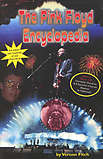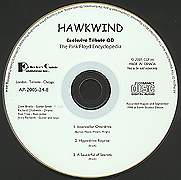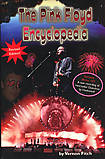

[Pink Floyd Archives home page]
[Pink Floyd Archives Book Database]

The Pink Floyd Encyclopedia
by Vernon Fitch
Includes:
1) The Pink Floyd Reference Encyclopedia
2) Pink Floyd Concert Appearance Listing
3) Syd Barrett Concert Appearance Listing
4) David Gilmour Concert Appearance Listing
5) Roger Waters Concert Appearance Listing
6) Richard Wright Concert Appearance Listing
7) Pink Floyd Equipment Appendix
8) Plus an exclusive CD of Hawkwind performing Interstellar Overdrive, Hyperdrive Reprise, and A Saucerful of Secrets (reprise)
448 pages
ISBN: 1-894959-24-8
Publisher: CG Publishing
The original idea behind The Pink Floyd Encyclopedia was to write a book that was different than other books that had previously been written about Pink Floyd. Most books deal with the band from a chronological point of view, analyzing them in their various stages, from their early years onward. I specifically did not want to do another history of Pink Floyd (its been done numerous times already, and there are already some good books of this sort available). Instead I wanted to create a unique reference work that could be used for research on the band. Although you can look up specific pieces of information in the many existing Pink Floyd books by either looking through an index, or browsing through a section that covers a certain period of the band, I felt that this was too time consuming and haphazard a research method. I wanted this book to deal directly with the information itself and present it in a way that makes it instantly accessible. That was the basis of The Pink Floyd Encyclopedia.
At its basic level, this book is an encyclopedia about the many facets of Pink Floyd, with hundreds of listings in alphabetical order. Numerous areas are covered. Every Pink Floyd album is listed, with details about cover art, production credits, U.S. and U.K. releases, release dates, studios and recording dates, sales awards, sales charts, songs, etc. Furthermore, every song on each album has its own listing with information such as recording studio, recording dates, records the song was released on, performance history, timings, musicians appearing on the song, etc. And not only are Pink Floyd albums included, but every solo album and every session that any member of Pink Floyd has ever done is categorized as well, both studio sessions and live sessions. In addition to albums and songs, every musician has their own listing, as well as every producer, engineer, studio, cover artist, etc., that has been associated at one time or another with Pink Floyd. It is possible to use the Encyclopedia to look up a studio and see a listing of every session that either Pink Floyd or any member of Pink Floyd has ever done at that studio. Or you can look up a musician and find any live or studio performances that particular musician has been involved in that included a member of Pink Floyd. And that is only part of what is included in the Encyclopedia.
I've done a number of Pink Floyd research projects over the years, everything from my continuing obsession with the 1967 U.S. tour to Roger Waters' flaming gongs. All these projects (including many that were done exclusively for this book) are included in the Encyclopedia. To name a few, I've researched their concert films, inflatables they have used in concert, the evolution of the Pink Floyd light show throughout the years, movies and videos with Pink Floyd involvement, Pink Floyd tour technicians, Hipgnosis, unreleased recordings, origins of lyrics, Pink Floyd's 1967 American Bandstand appearance (I've even included a transcription of the Dick Clark interview with the band on American Bandstand that helps define the date of the appearance and the tour itself), Intrepid Aviation, Ten Tenths, 7th Level, etc. And these are just a sampling of the research projects that have gone into the book.
And the great thing is that all this information is indexed for instant retrieval. For example, if you want to research what inflatables that Pink Floyd has used in concert throughout the years, just look under inflatables and you will find listings detailing every inflatable used by Pink Floyd, by specific concert or specific tours over a 20+ year period. Or if you want to know who Peter Watts was and what Pink Floyd performances he was involved with, just look under his name. It's been laid out in an easily accessible manner.
One of my intents for this book was to write a reference book that could be used by other writers for their research on Pink Floyd, and I feel that it works well as such. But I also think that anyone who is the least bit interested in Pink Floyd will find that this book will help them understand the numerous facets of the band. I've learned alot myself from writing the book, and I hope that it will prove insightful to everyone who reads it.
In addition to the extensive Pink Floyd Encyclopedia in the first part of the book, this book also includes numerous appendices of Pink Floyd related information.
Appendix A: Concert Dates
Concert Dates Appendices: The first appendix of The Pink Floyd Encyclopedia is a concert dates appendix. This appendix lists every concert performance by Pink Floyd and band members in chronological order by date and venue. In this appendix you can look up any performance that Pink Floyd has ever done. In addition to the dates listed, many promo ads for the various concerts are pictured alongside the dates. I have done extensive research of these dates and compiled what is the most accurate and up to date listing of Pink Floyd concert performances currently in print.
Equipment Listing Appendix: Appendix B of The Pink Floyd Encyclopedia is a listing of the equipment used by Pink Floyd and band members throughout the years. This listing is separated into the various periods of the band, as well as solo performances, with each period divided up by band members, followed by their equipment, and specific sessions in which a particular instrument is known to have been used. Although this list is very extensive, it is not a complete listing of every piece of equipment ever used by the band, and the session listing should not be viewed as the only times a particular instrument was used. This is an overview of the known pieces of equipment the band has used throughout the years, assembled as a research tool for those interested in pursuing the technical aspects of Pink Floyd. At the end of this appendix is "A Collection of Unusual Guitar Tunings" that have been used in various Pink Floyd songs over the years.

Catalog number: AP-2005-24-8
Songs: Interstellar Overdrive, Hyperdrive Reprise, A Saucerful of Secrets (reprise)
Musicians:
Dave Brock - Guitar, synthesizer, and keyboards
Richard Chadwick - drums
Ron Tree - Bass guitar
Jerry Richards - guitar and keyboards
Produced by Dave Brock
First two songs recorded in August and September 1998 at Earth Studios, Devon
During the writing of The Pink Floyd Encyclopedia, it was decided to include a CD with the book. And since the Encyclopedia encompasses the various bands and musicians that Pink Floyd members have been involved with in sessions throughout the years, it was thought that it would be particularly interesting to have one of the bands that has played with a member of Pink Floyd in the past go into the studio and record a Pink Floyd song for the book.
One of my favorite of these bands, and one that still encompasses the spirit of the early Pink Floyd, is Hawkwind, so Dave Brock was approached and asked if Hawkwind would go into the studio and record a version of Interstellar Overdrive for exclusive release with this book. He agreed, and Hawkwind went into Earth Studios in Devon, England in the fall of 1998 and recorded Interstellar Overdrive as well as a brand new Hawkwind song, called Hyperdrive Reprise, which is a Pink Floyd / Syd Barrett tribute. These two songs appear exclusively on the CD packaged with The Pink Floyd Encyclopedia.
For the third edition of The Pink Floyd Encyclopedia, Dave Brock contributed an additional tribute song, titled, A Saucerful of Secrets (reprise). This song, complete with repeating drum patterns, synth sweeps, and dialog about food in outer space(!), is also an exclusive release with this book!

When I originally wrote The Pink Floyd Encyclopedia, I hoped to accomplish two things that are not usually done with published books. First, I wanted to be sure that I was accessible as an author. Too many books are written where there is no way to contact the author. I feel that communication is important, and as a result I have made myself available for everyone to contact. Both my e-mail address and my regular mailing address are printed at the beginning of the book, so anyone can write me. And I encourage people to do so. I feel that sharing information is an important research tool. I have already received alot of feedback, new information, etc., and it has only helped to improve The Pink Floyd Encyclopedia. Keep the feedback coming!
Secondly, I wanted The Pink Floyd Encyclopedia. to be an evolving project. I didn't want it to be published just once, and have it fixed in that form forever. I wanted to have the ability for it to be expanded as new information came to light. In this way, I felt that it would get better, and the second edition of the book has accomplished that.
The second edition of The Pink Floyd Encyclopedia was published in November 1999. Included in the revised second edition are the following:

In 2004, it was decided to release a third edition of The Pink Floyd Encyclopedia. Five years had passed since the previous edition had been published, and lots of new information had been uncovered. Included in the new revised third edition are the following:
The third edition of The Pink Floyd Encyclopedia is a major revision to what is considered "the bible" of Pink Floyd facts and information. It is one of the most complete Pink Floyd reference work ever published.

One of the many interesting aspects of The Pink Floyd Encyclopedia is the imagery contained on the cover. This beautiful cover was designed by artist Robert Godwin. I assisted him with ideas for the design, and I thought I would explain the significance of the various pictures used on the cover.
Starting at the top, there is a river that is ever widening and that flows down the cover. This river symbolizes the history of the band which started as four local musicians and has widened into an international phenomenon. The river is also a symbol that has been used by Pink Floyd themselves in recent years to signify the continuing flow of musical ideas.
At the bottom of the cover is a picture of Pink Floyd in concert during their Division Bell tour in 1994. It includes the musicians that contributed to Pink Floyd's live sound in the 1990s. Yet on the screen above the stage, which has been called a doorway to another dimension or to the past, is a picture of the madcap laughing. This signifies Syd Barrett as a part of Pink Floyd's past, and his continuing influence on the band. One can only surmise that the madcap is still laughing.
Above the Division Bell stage is a picture of the modern day David Gilmour singing and playing guitar. As the current leader of the band, he represents the voice of Pink Floyd in today's world.
But to the left of David, and slightly faded from view, is Roger Waters. Roger is still a part of what Pink Floyd is today, although he is no longer directly involved in making music under that name. The fact that David Gilmour's microphone stand comes from where Roger is located signifies that many of the songs that David still sings originated from the mind of Roger Waters.
I hope you enjoyed this review of the cover of The Pink Floyd Encyclopedia. All the members of the band, both past and present, were included as they are all a part of what Pink Floyd is today. I think this cover is really excellent and I'd like to thank Robert Godwin for doing such an excellent job on it. It's just another great reason to purchase a copy of this book.

The following is a list of published reviews of The Pink Floyd Encyclopedia:
